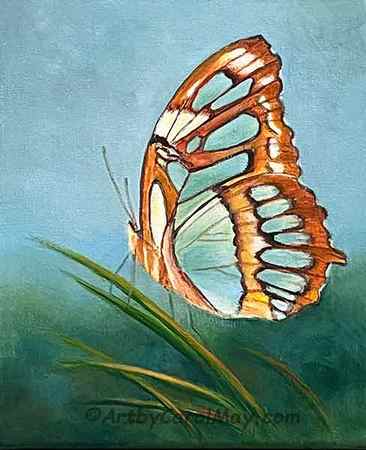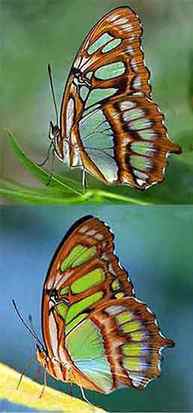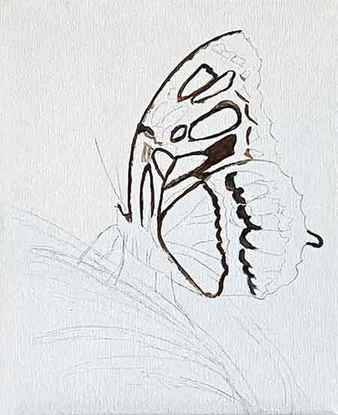Paint the dark browns or black.
how to Paint a Butterfly from wings to canvas: a Comprehensive guide
Welcome artists, have you ever wanted to learn how to paint a butterfly? They certainly are an enchanting subject. Many artists are inspired by their colors and interesting patterns.
The steps below and will set you mind at ease about painting butterflies. Whether you are a budding artist or are polishing your painting skills, you will find painting tips and techniques for everyone.
This painting uses the basics of oil painting. You can use the same techniques for more butterfly paintings or any other subject you desire.

You can paint a butterfly step-by-step.
what do we need for this butterfly painting?
This painting tutorial is tailored for oil and alkyd paints. Acrylics use much the same steps. Watercolor artists have three butterfly tutorials on this website, so it’s time for the oil painters.
Oil or alkyd paint?
When I started painting in the 1970s the instructor recommended Winsor & Newton paint. There are many good brands of art paint, but I still use Winsor & Newton paints.
Whatever brand you use, it’s a good idea to use the same brand for all your colors. Different companies make their paints thicker or thinner. Why muddle up the learning process by using a variety of paints that have different painting consistencies.
what are alkyds?
Alkyd paint is manufactured with the same pigments as oil paint. Oil paint mixes the pigments with linseed oil. Alkyds have the pigments mixed with alkyd resin.
Alkyds are used like oil paint. The finished painting looks just like an oil painting. There is no discernible difference. But there are distinct advantages to alkyds.
Alkyds are workable for several hours. They dry completely within 24 hours. Griffin Alkyds by Winsor & Newton have a good painting consistency, so they don’t require any painting medium. Mineral spirits is used for underpainting and cleaning brushes.
this painting uses a simple color palette
Color is awesome! It is one of the great joys of painting, but it’s easy to get carried away with too many colors. Let’s use only three colors for this butterfly painting.
- Burnt Sienna
- Cadmium Yellow
- Phthalo Blue
- White doesn’t count as a color.
canvas and brushes
Oil painting is normally done on stretched canvas. But canvas panels are great for learning how to paint a butterfly. Plus, they are less expensive for practice painting.
This painting is on an 8×10″ canvas.
Three brushes were used:
- 1/2″ angle brush
- #6 round
- #6 flat
reference material
Butterflies don’t stay on the flowers long enough to be painted. So, unless we happen to have a mounted butterfly, photos are our best option.
We will be painting one of the few green butterflies, the beautiful Malachite Butterfly.
The top side of their wings can be very green and sometimes the brown looks black.
We will be painting the underside of the wings where the green looks more turquoise or aqua.
i have never had the privilege of seeing a Malachite Butterfly in real life. There seems to be a variation of the colors in different photos.
Most of the photos I saw lean towards turquoise on the underside of the wings, so that’s how I painted it.
You certainly may paint them greener. It’s a matter of individual preference.
Also notice there is some difference between the shape of some of the colored spots between the two photos.
Nature is not perfect. We let this relieve our mind while we are drawing the butterfly.

Notice the variations.
getting ready to paint the butterfly
Draw the butterfly on the canvas. The drawing will include the main color patterns and a few veins. My favorite way is to do the drawing on paper first. Then transfer it to the canvas with graphite paper.
Good composition very seldom centers the main subject. Position the butterfly on the canvas with various areas around it for the background. What is good composition?
paint the dark colors

Paint the dark browns or black.
Refer to the reference photo and identify the darkest colors.
Mix blue and orange to get the dark color of your choice. More orange (Burnt Sienna) in the mixture will create brown. More blue in the mixture will make a black.
Thin the dark mixture with your medium. Oil paint may be thinned with linseed oil. Gamsol, an odorless mineral spirits is perfect for thinning alkyd paint.
Paint the dark colors using a round brush. The lines don’t have to be perfect.
Relax and enjoy painting. That’s how to paint a butterfly.
how do we use oil paint?
There are two basic guidelines for using oil and alkyd paints.
- Paint ‘dark to light’. Paint the dark colors first. Highlights are painted last.
- Paint ‘thin to thick’. The first paint layer is thinned with medium. As the painting progresses, use less thinner. The final layers are straight paint.
This may also be called ‘fat over lean’ because the first layer is thinned paint. The last layer is called fat because oil paint is made with linseed oil.
Step 1
By loading my brush with Transparent Orange and quite a lot of water, I create a smooth wash of orange fading into yellow in the forewings of the butterfly. By adding Cadmium-Free Lemon, the colours blend nicely into each other. I fill the rest of the wings with colour by continuing to add water to the colour.

Step 2
In the wet orange area, I dot some Rose Madder Genuine at the top. The orange paint is slowly drying but still wet. This means the colour can run into it. Use a paper towel to ensure that the orange doesn’t run outside the line of the wing. Once the forewings are dry, I use the warm blue Smalt for the hindwings.

Step 3
I paint this blue in the same free and light way as the orange in the forewing. While it’s still wet, I dot more Smalt and some Payne’s Grey where the wing joins the body, creating a nice gradation from dark to light. At the bottom of the wing, I use more Transparent Orange and Cadmium-Free Lemon. Try to avoid the colours running into the blue area too much. While the hindwing is drying, I paint the body in a watery blue.






